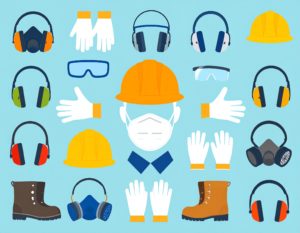The specific hazards that may be encountered on the job are among the factors you should carefully consider before choosing personal protective equipment (PPE)

PPE is an essential component of any tradesperson’s toolkit. It provides a crucial barrier against hazards that could cause injuries or illnesses on the job. By understanding the importance of PPE and choosing the right gear for your specific trades, you can significantly reduce the risk of accidents and maintain long-term health.
- Preventing injuries – PPE can protect you from cuts, scrapes, burns, and other physical injuries that can occur on the job. For example, safety gloves can prevent cuts and abrasions, while hard hats can protect your head from falling objects.
- Protecting against hazardous substances – PPE can shield you from exposure to harmful chemicals, solvents, and other hazardous materials. Chemical-resistant gloves and aprons can protect your hands and body from exposure to corrosive substances, while respiratory protection can prevent you from inhaling harmful fumes.
- Providing thermal protection – PPE can keep you warm in cold weather or cool in hot environments. Insulated clothing can protect you from the cold, while breathable fabrics can help to regulate your body temperature in hot weather.
- Improving visibility – PPE can make you more visible to others, reducing the risk of accidents. High-visibility clothing, such as vests or jackets, can help you be seen in low-light conditions or around heavy machinery.
- Compliance with regulations – PPE can help you comply with health and safety regulations that are specific to your industry. Many trades have specific requirements for protective clothing, and failure to comply can result in fines or other penalties.
When you are selecting protective clothing, it is important to consider the specific hazards that you may encounter on the job. You should also ensure that the clothing you choose is comfortable, durable, and meets the relevant safety standards. It is often advisable to consult with a health and safety professional to determine the appropriate level of protection for your specific needs.
Other factors that you should consider when choosing the right protective clothing include:
- Fit – The clothing should fit properly and be comfortable to wear. Loose-fitting clothing can be a hazard in certain situations, as this can get caught in machinery or equipment.
- Durability – The clothing should be made from durable materials that can withstand the rigors of your job. Look out for clothing that is resistant to punctures, tears, or abrasion.
- Visibility – If you work in a high-visibility environment, choose clothing that is bright in colour and has reflective strips.
- Maintenance – Consider how easy the clothing is to clean and maintain. Some types of protective clothing may require special cleaning procedures and may also need to be replaced more frequently.
To ensure your protective clothing remains effective, it is important to maintain it properly. This includes washing it regularly, inspecting it for damage, and replacing it when necessary. Some types of protective clothing may require special cleaning or particular maintenance procedures.
- Wash it regularly – Wash your protective clothing according to the manufacturer’s instructions. Some types of clothing may need to be washed in hot water or with a special type of detergent.
- Inspect it for damage – Inspect your protective clothing for any signs of wear and tear. This can include things like frayed seams, tears, or holes. If you do find any damage, repair or replace the clothing immediately.
- Replace it when necessary – Protective clothing can begin to deteriorate over time. Even if it appears to be in good condition, it can still deteriorate and may not be as safe or effective as you think. Replace your protective clothing regularly, especially if it is regularly exposed to harsh conditions or chemicals.
By investing in high-quality protective clothing and maintaining it properly, you’re making a significant investment in your safety and well-being. Remember, as a tradesperson, your health is your most valuable asset.
By prioritising your safety on the job, you can ensure a long and successful career. Don’t hesitate to consult with a health and safety professional or your employer if you have any questions about the appropriate protective clothing for your specific trade.
Taking the time to choose and maintain the right protective gear is an essential step in protecting yourself from workplace hazards.
There are many different types of protective clothing available. Each type is designed to protect against specific hazards. Some common examples include the following:
- Hard Hats – Hard hats protect your head from falling objects and other impact hazards. These are essential for tradespeople who are working in construction, demolition, and other industries where head injuries are a high risk. Hard hats come in a range of styles and can be made from various materials such as fibreglass, plastic, and composite materials.
- Safety Glasses and Goggles – Safety glasses and goggles protect your eyes from things like flying debris, chemicals, and other hazards. These are essential for tradespeople working with chemicals, power tools, and in dusty environments. Safety glasses and goggles can be prescription or non-prescription, and they may have some additional features such as UV protection or side shields.
- Hearing Protection – Hearing protection can include things like earplugs or earmuffs. These can protect your hearing from excessive noise exposure. This is particularly important for tradespeople who work with very loud machinery or equipment. Earplugs and earmuffs come in a range of styles and can be made from various materials. You can also choose from disposable or reusable options.
- Gloves – Gloves will help to protect your hands from burns, cuts, chemicals, and other hazards. The type of gloves you need will depend on the specific tasks you perform. For example, leather gloves may help to protect against cuts and abrasions, while rubber gloves can help to protect your hands against chemicals. Other types of gloves include wielding gloves, nitrile gloves, and Kevlar gloves.
- Footwear – Appropriate footwear is essential for protecting your feet from potential injuries. Safety boots or shoes with steel toe caps can protect your toes from falling objects. Non-slip soles are helpful in preventing slips and falls. Safety footwear may also have some other features, such as puncture-resistant soles or ankle support.
- Body Protection – In some trades, body protection may be necessary to protect your from certain hazards such as flying debris or chemical splashes. Some examples include coveralls, aprons, or full-body suits. Aprons can help to protect your torso from spills and splashes, while coveralls can provide full-body protection.








